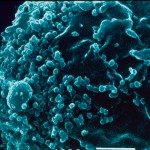Link to Pubmed [PMID] – 17329448
J. Clin. Microbiol. 2007 May;45(5):1572-80
Genotypic population-based methods could be faster and less expensive than phenotypic recombinant assays for determining human immunodeficiency virus type 1 (HIV-1) coreceptor usage in patient samples, but their clinical use requires good genotype-phenotype correlation and concordance with clonal analyses. We have assessed these requirements by clonal analysis of the V1 to V3 env PCR products of 26 patients infected with subtype B HIV-1. We used the resulting set of molecular clones, all sequenced and characterized using a single-cycle recombinant virus phenotypic entry assay, to reevaluate genotype-phenotype correlations. Combining the previously described 11/25 and net charge rules for the V3 genotype improved the prediction of HIV-1 coreceptor usage. We also evaluated the concordance of population-based and clonal analyses for predicting the coreceptor usage of HIV-1 quasispecies. Our population-based recombinant phenotypic assay and direct sequencing of V3 were similarly sensitive for detecting the presence of minor species in the virus population, and both correlated well with clonal analysis. The improved genotype-phenotype correlation obtained by combining two simple genotypic rules and the good concordance with clonal analyses suggest that direct sequencing of V3 is a valuable alternative to population-based recombinant phenotypic assays.

